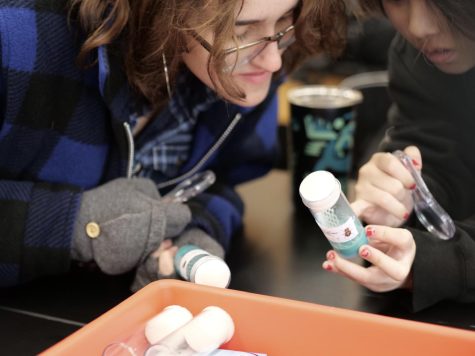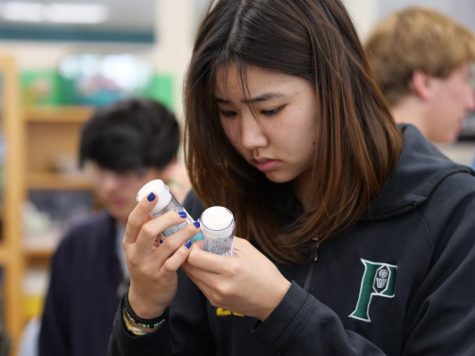Mendelian Biology: Bio Students Breed Fruit Flies
Featuring Kim Hudson.
February 28, 2023
Honors Biology 2 students are currently facing their most challenging task to date: a lab investigating Mendelian genetics, the process of inheritance, where certain traits are passed down from parent to offspring. Students will observe these traits through Drosophila melanogaster, also known as the common fruit fly. Through this lab, students explore this phenomenon up close, adding on to previously learned concepts in their current genetics unit, which they began in January.
Some people might wonder: why use the fruit fly? Science Department Chair and biology teacher Kim Hudson said that Drosophila melanogaster is used often in genetics, embryological, and developmental research.

“Fruit flies have been used as research animals of choice for more than 100 years because of their convenient size, short generation time, and easily observed physical traits,” Hudson said. “The first gene linked to a chromosome was identified using them.”
A process known as “crossing” is a key element of the lab that students will use. Crossing refers to breeding parents that display different sets of observable traits, phenotypes, such as size, eye color, or blood type.
“One cross might be normal female, red-eyed flies with mutant male, white-eyed flies,” Hudson said. “In conjunction, the rules of inheritance Gregor Mendel discovered allow us to work backward to determine how a trait is passed down over generations.”
In this lab, students will perform the crossing themselves by selecting flies with different traits.
“[The students’ task is to] predict the genetic inheritance pattern of a specific cross they set up,” Hudson said.
The offspring of crosses between mutant traits such as wingless flies and normal flies will provide insight into how such traits are inherited. Furthermore, students will be required to perform a second cross to finalize their results. The lab is expected to run for multiple weeks, if not months, to collect the required data. In addition to waiting for the flies to breed, they have to be sorted by gender. Despite its lengthy processes, the lab prepares the students for future, higher level biology courses, and strengthens research skills.

“The goal is for students to be exposed to all stages of research,” Hudson said. “It hits all the main requirements for experimentation as well as introduces the idea that biology is not a fast science. When working with living organisms, patience is key.”
In addition to their long term research project, the Honors Biology 2 students are undertaking a variety of additional activities to become acquainted with higher level science. Just weeks prior, they completed a lab that simulated a process known as genetic transformation. In a similar fashion, students were tasked to make observations over several classes, which exposed them to the prolonged nature of biological proceedings.
Whether it is in genetics, cell division, or evolution, students are consistently challenged to formulate impactful hypotheses, make significant observations, and engage in the broader scientific community with their peers.







